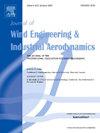在天气风和非天气风的作用下,通过气动弹性代替物进行桥面的气动结构设计,包括形状、减速速度和平均迎角
IF 4.9
2区 工程技术
Q1 ENGINEERING, CIVIL
Journal of Wind Engineering and Industrial Aerodynamics
Pub Date : 2025-07-14
DOI:10.1016/j.jweia.2025.106133
引用次数: 0
摘要
风敏桥梁通常是根据其在天气风作用下的气动弹性响应来设计的。然而,一个整体的航空结构设计框架必须考虑桥梁生命周期中所有可能的风情景,包括非天气事件和天气风,由于风引起的甲板静力变形或复杂地形影响,平均迎角会发生相关变化。这就要求在评估气动弹性响应时考虑流固耦合参数对风攻角的敏感性。为了在设计框架内正确建模这些影响,本研究提出利用一个多向气动弹性Kriging代理,通过强迫振动CFD模拟来模拟颤振导数作为甲板形状、减速速度和平均攻角的函数。详细研究了从流线型结构到钝型结构的变深度桥面,发现相关的颤振导数发生了剧烈变化。在一些临界颤振导数中,甲板形状驱动平均攻角的影响,包括A2 *符号翻转的发生,及其对扭转稳定性的影响。由此产生的气动弹性替代物被认为是集成到空气结构优化框架中,以优化天气和非天气风情景下的桥面形状。本文章由计算机程序翻译,如有差异,请以英文原文为准。
Aero-structural design of bridge decks under synoptic and non-synoptic winds via aeroelastic surrogates comprising shape, reduced velocity, and mean angle of attack
Wind-sensitive bridges are commonly designed based on their aeroelastic responses under synoptic winds. However, a holistic aero-structural design framework must address all potential wind scenarios along the bridge life cycle, including non-synoptic events and synoptic winds with relevant variations in the mean angle of attack due to wind-induced static deck deformation or complex terrain effects. This requires the evaluation of the aeroelastic responses considering the sensitivity of the fluid-structure interaction parameters to the wind angle of attack. Aiming at properly modeling these effects within design frameworks, this study proposes harnessing a multi-directional aeroelastic Kriging surrogate trained with forced vibration CFD simulations to emulate the flutter derivatives as a function of the deck shape, reduced velocity, and mean angle of attack. A bridge deck with a variable depth ranging from streamlined to bluff configurations is studied in detail, showing drastic changes in relevant flutter derivatives. The deck shape drives the impact of the mean angle of attack in some critical flutter derivatives, including the occurrence of A2∗ sign flipping, with its implications in the torsional stability. The resulting aeroelastic surrogate is conceived to be integrated into aero-structural optimization frameworks for optimally shaping bridge decks under synoptic and non-synoptic wind scenarios.
求助全文
通过发布文献求助,成功后即可免费获取论文全文。
去求助
来源期刊
CiteScore
8.90
自引率
22.90%
发文量
306
审稿时长
4.4 months
期刊介绍:
The objective of the journal is to provide a means for the publication and interchange of information, on an international basis, on all those aspects of wind engineering that are included in the activities of the International Association for Wind Engineering http://www.iawe.org/. These are: social and economic impact of wind effects; wind characteristics and structure, local wind environments, wind loads and structural response, diffusion, pollutant dispersion and matter transport, wind effects on building heat loss and ventilation, wind effects on transport systems, aerodynamic aspects of wind energy generation, and codification of wind effects.
Papers on these subjects describing full-scale measurements, wind-tunnel simulation studies, computational or theoretical methods are published, as well as papers dealing with the development of techniques and apparatus for wind engineering experiments.

 求助内容:
求助内容: 应助结果提醒方式:
应助结果提醒方式:


